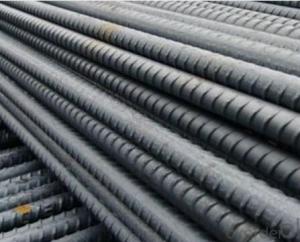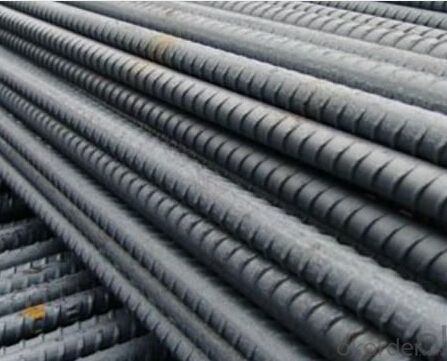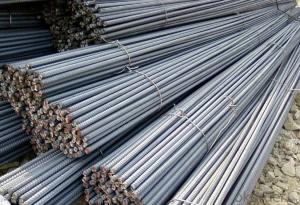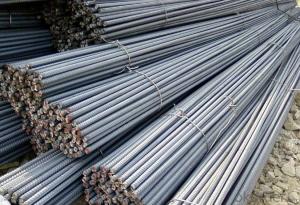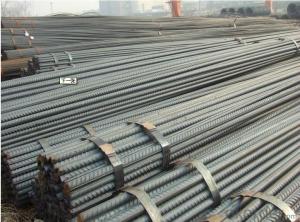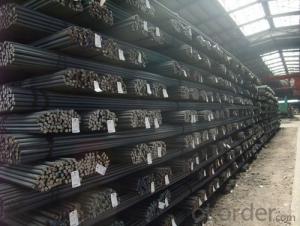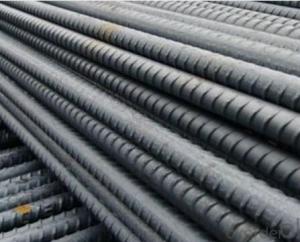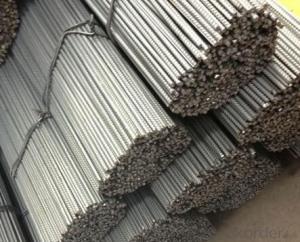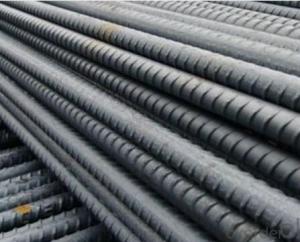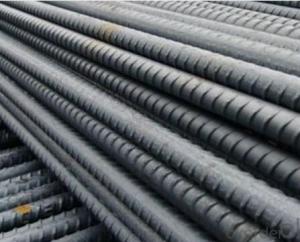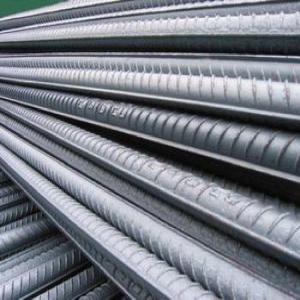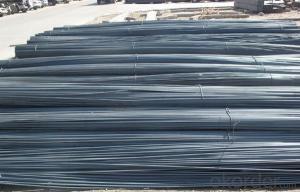DIN STANDARD HIGH QUALITY HOT ROLLED STEEL REBAR
- Loading Port:
- Tianjin
- Payment Terms:
- TT OR LC
- Min Order Qty:
- 50 m.t.
- Supply Capability:
- 100000 m.t./month
OKorder Service Pledge
OKorder Financial Service
You Might Also Like
Product Description:
Specifications of Hot Rolled Steel Rebar:
The production process of Steel Rebar
1-Waling beam furnace 2-Roughing rolling group 3-Intermediate rolling train
4-Finishing rolling group 5-Water-cooling device 6-Walking beam cooler
7-Finishing equipment(including the cold scale shear,short feet collection system,
automatic counting device,bundling machine, collect bench)
Usage and Applications of Hot Rolled Steel Rebar:
Deformed bar is widely used in buildings, bridges, roads and other engineering construction. Big to highways, railways, bridges, culverts, tunnels, public facilities such as flood control, dam, small to housing construction, beam, column, wall and the foundation of the plate, deformed bar is an integral structure material. With the development of world economy and the vigorous development of infrastructure construction, real estate, the demand for deformed bar will be larger and larger..
Packaging & Delivery of Hot Rolled Steel Rebar:
Packaging Detail: products are packed in bundle and then shipped by container or bulk vessel, deformed bar is usually naked strapping delivery, when storing, please pay attention to moisture proof. The performance of rust will produce adverse effect.
Each bundle weight: 2-3MT, or as required
Payment terms: TT payment in advance or Irrevocable LC at sight.
Trade terms :FOB, CFR, CIF
Label:to be specified by customer, generally, each bundle has 1-2 labels
Note:
1. Our products are produced according to national standard (GB), if not, supply according to national standards (GB) or agreement as customer required.
2. Other Grade and Standard Deformed Steel Bar we can supply:
Grade: GR40/GR60, G460B/B500A/B500B/B500C,BST500S
Standard: ASTM, BS, DIN
The Minimum Order Quantity of these products is high, and need to be confirmed.
3. We can not only supply Deformed Steel Bar; if you need anything about building materials, please contact us for further information.
4. Please send us your detail specifications when inquire. We will reply to you as soon as possible. We sincerely hope we can establish a long stable business relationship.
- Q: What are the factors that can affect the lifespan of steel rebars in concrete structures?
- There are several factors that can affect the lifespan of steel rebars in concrete structures. Firstly, the quality and composition of the concrete used in the structure play a significant role. If the concrete is of poor quality or contains harmful chemicals, it can cause corrosion of the steel rebars, leading to a shorter lifespan. Adequate measures should be taken during the construction process to ensure the concrete mixture is properly proportioned and cured. Secondly, the exposure conditions that the concrete structure is subjected to can greatly impact the lifespan of steel rebars. Factors such as humidity, temperature variations, and the presence of aggressive substances like chloride ions or carbon dioxide can accelerate the corrosion process. Structures located in coastal areas or industrial environments are particularly vulnerable due to the high salt content in the air or the presence of pollutants. Thirdly, the design and construction practices employed have a significant impact on the longevity of steel rebars. Proper cover thickness, which refers to the distance between the surface of the rebar and the outer face of the concrete, is crucial. Inadequate cover thickness can lead to insufficient protection against corrosion. Additionally, the design should incorporate effective drainage systems to prevent the accumulation of water around the rebars, as stagnant moisture can accelerate corrosion. Furthermore, maintenance practices also play a role in the longevity of steel rebars. Regular inspections, cleaning, and repairs can help identify and address any issues before they become severe. Applying protective coatings or using corrosion inhibitors can also extend the lifespan of the rebars. Lastly, the type and quality of the steel rebars themselves are important factors. Rebars with higher levels of carbon and alloying elements are generally more resistant to corrosion. Additionally, the quality of the manufacturing process and the presence of any impurities can affect the rebars' durability. In conclusion, the lifespan of steel rebars in concrete structures can be influenced by various factors including the quality of the concrete, exposure conditions, design and construction practices, maintenance, and the quality of the rebars themselves. Proper attention to these factors can help ensure the longevity and structural integrity of concrete structures.
- Q: How do steel rebars prevent cracks and structural failures?
- Steel rebars prevent cracks and structural failures by providing reinforcement and strength to concrete structures. When embedded in concrete, rebars enhance the tensile strength of the overall structure, enabling it to withstand applied forces and loads without cracking or failing. The presence of rebars helps distribute stress and load more evenly throughout the concrete, reducing the likelihood of cracks and failures.
- Q: What are the best practices for handling and storing steel rebars on a construction site?
- The best practices for handling and storing steel rebars on a construction site include: 1. Properly storing the rebars on a flat and well-drained surface to prevent damage and rust. 2. Keeping the rebars off the ground using pallets or other suitable supports to avoid contact with moisture. 3. Organizing the rebars by size, type, and length to ensure easy access and minimize handling risks. 4. Securing the rebars with tie wires or rebar caps to prevent any accidental displacement. 5. Providing adequate space and clear signage to avoid any tripping or safety hazards. 6. Regularly inspecting the rebars for any signs of rust, deformation, or damage and removing any defective ones from use. 7. Lifting and moving rebars with appropriate equipment, such as cranes or forklifts, to avoid strain or injuries. 8. Keeping the rebars protected from inclement weather conditions by covering them with tarps or waterproof materials. 9. Training and educating construction workers on proper handling techniques and safety protocols related to steel rebars. 10. Adhering to local regulations and industry standards for the storage and handling of steel rebars.
- Q: How do steel rebars affect the flexural strength of reinforced concrete elements?
- Steel rebars significantly enhance the flexural strength of reinforced concrete elements by providing tensile strength to counteract the concrete's weakness in tension, resulting in a more durable and resilient structure.
- Q: Can steel rebars be used in the construction of educational institutions?
- Yes, steel rebars can be used in the construction of educational institutions. Steel rebars are commonly used in reinforced concrete structures to provide strength and durability. They help reinforce and support concrete, making it suitable for various construction projects, including educational institutions. The use of steel rebars ensures the structural integrity of buildings, allowing them to withstand the test of time and provide a safe learning environment for students and faculty.
- Q: What are the different coating options available for steel rebars?
- There are several different coating options available for steel rebars, including epoxy coatings, zinc coatings, and galvanized coatings. Epoxy coatings provide a protective layer that helps prevent corrosion and increase the lifespan of the rebar. Zinc coatings, such as hot-dip galvanizing, provide excellent corrosion resistance by creating a barrier between the steel and the environment. Galvanized coatings involve the application of a layer of zinc to the rebar, offering enhanced protection against rust and corrosion. These coating options can be chosen based on the specific needs and requirements of the project or application.
- Q: Can steel rebars be used in structures with high aesthetic requirements?
- Yes, steel rebars can be used in structures with high aesthetic requirements. While steel rebars are primarily used for their strength and durability, they can also be designed and incorporated in a way that meets aesthetic requirements. Rebars can be shaped, bent, or painted to match the desired aesthetic of the structure. Additionally, they can be hidden within the structure or covered by other materials to maintain a clean and visually appealing appearance. With careful planning and design, steel rebars can be successfully used in structures with high aesthetic requirements without compromising their functionality or visual appeal.
- Q: What is the process of calculating the required quantity of steel rebars for a project?
- Calculating the necessary amount of steel rebars for a project involves several crucial steps. To begin, one must identify the project's design requirements and specifications. This entails comprehending the structural drawings, plans, and relevant building codes or regulations. Next, it is necessary to pinpoint the specific areas where steel rebars will be utilized. This encompasses foundations, columns, beams, slabs, and any other structural elements necessitating reinforcement. Once the areas are determined, the total length of rebars required for each element must be calculated. This is achieved by measuring the dimensions of the elements and establishing the necessary spacing and overlap of the rebars. Upon obtaining the lengths, consideration must be given to the bar diameter and spacing requirements specified in the design. This aids in determining the number of rebars needed for each element. In addition to length and quantity, wastage and additional reinforcement requirements must also be taken into account. It is customary to incorporate a percentage of wastage (typically around 2-5%) to accommodate the cutting and bending of the rebars. Moreover, extra bars may be necessary for special conditions or to meet the design requirements. Lastly, a comprehensive bar bending schedule (BBS) should be created. This schedule includes crucial information such as bar sizes, lengths, shapes, and placement details. It serves as a guide for the construction team during the installation process. It is important to note that the process of calculating the required quantity of steel rebars may vary depending on the complexity and size of the project. It is advisable to consult with a structural engineer or professional rebar detailer to ensure precise calculations and adherence to the project's specifications.
- Q: How do steel rebars affect the overall fire rating of a building?
- Steel rebars can have a positive impact on the overall fire rating of a building. By reinforcing concrete structures, rebars can help enhance the fire resistance of the building. Steel has high melting and ignition temperatures, which means it can withstand heat and maintain its structural integrity for longer periods during a fire. This additional durability provided by rebars can help prevent structural collapse, allowing occupants more time to evacuate safely and aiding firefighters in their efforts to suppress the fire.
- Q: What are the common quality tests performed on steel rebars?
- Steel rebars undergo several common quality tests to guarantee their strength and durability, ensuring they meet the necessary standards and can withstand the intended load and environmental conditions. The tensile test is one of the most prevalent quality tests for steel rebars. This test determines the maximum amount of tensile stress the rebar can bear before breaking, providing insights into its tensile strength and ductility. Another significant quality test is the bend test, which involves bending a rebar at a specific angle without it breaking. This test evaluates the rebar's flexibility, resistance to cracking or fracturing, and is particularly crucial for construction projects requiring bending or shaping. Chemical composition analysis is conducted to determine the percentage of various elements present in the steel rebars, such as carbon, manganese, phosphorus, sulfur, among others. This analysis ensures that the rebars meet specific requirements and do not contain any impurities that could jeopardize their strength or corrosion resistance. Corrosion resistance is also a vital property for steel rebars, especially in high-moisture or chemically exposed environments. A corrosion test is performed by subjecting the rebars to corrosive environments like salt spray or acidic solutions, assessing their resistance to corrosion. This test helps determine the rebars' suitability for specific applications and prevents premature degradation. Lastly, dimensional tests are conducted to verify that the rebars meet required dimensions and tolerances. These tests involve measuring the rebars' length, diameter, and weight. Deviations from specified dimensions can impact the rebars' structural integrity and compatibility with other construction materials. In summary, quality tests for steel rebars include tensile testing, bend testing, chemical composition analysis, corrosion resistance testing, and dimensional testing. These tests are crucial in ensuring the strength, durability, and suitability of steel rebars for various construction applications.
Send your message to us
DIN STANDARD HIGH QUALITY HOT ROLLED STEEL REBAR
- Loading Port:
- Tianjin
- Payment Terms:
- TT OR LC
- Min Order Qty:
- 50 m.t.
- Supply Capability:
- 100000 m.t./month
OKorder Service Pledge
OKorder Financial Service
Similar products
Hot products
Hot Searches
Related keywords
